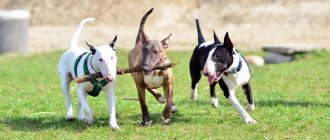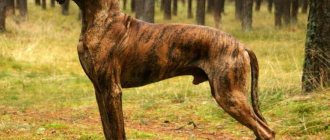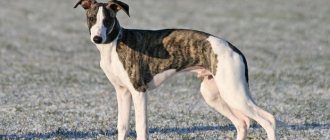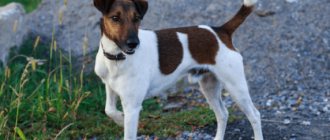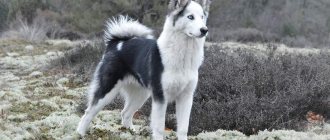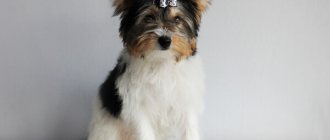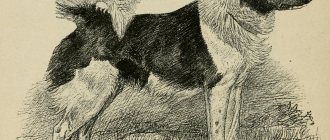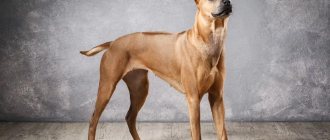Black
Absolutely black huskies are called Afrohuskies. They are very rare. Blue-black hair does not exist in these dogs. The reason for this: a genetic feature. To classify a species as completely black, 75% dark hair is enough. Other shades are allowed on the paws, tip of the tail, and muzzle. The area around the eyes, lips and nose are the same color as the main skin.
Classification and description of husky colors
Interesting! It is believed that pigmentation and character are closely related.
Breeders believe that dog behavior is more influenced by training and education, but not by color. However, scientists are confident that color directly affects the health of animals - the lighter the coat, the weaker the dog’s body.
Red and brown
The pure, rich color of the Husky comes in copper or golden shades. Such dogs are sure to have at least one white spot. Other colors:
- Fawn – dark cream or beige.
- Copper is a transitional color when it is impossible to clearly say whether a husky is red or brown.
- Piebald - small red spots located on a white background.
- Sable - at the base the hairs are light or reddish, and the tips are dark, even chocolate or black.
Pure red individuals cannot be found
Gray
A very common type. The husky's gray color must be pure, and the undercoat can be silver, beige, cream or fawn. The rims of the eyes, pigmentation of the lips and nose are exclusively black according to the standard.
This type also includes a silver color, which completely eliminates the presence of beige shades of the undercoat. It should only be white or silver. The pigmentation of the eyes, nose and lips is also black.
Cheprachny
A saddle blanket is the name given to the lining under a horse's saddle, so the color of a white husky, which has a dark spot on its back, is designated as saddle-back in the classification. The shades of the “saddle” may be different.
Wolf
This is a husky with a wolf-like coloring. The coat may be gray with reddish or yellow markings. Such spots are often located behind the ears, on the withers, forearms, legs, thighs, and hocks. The undercoat of a wolf-colored husky is always beige. The color of the nose, lining of the eyes and lips is only black according to the standard.
Splash
Coloration in the form of a mantle on the back of the animal. Large spots of reddish tints are scattered from the withers to the tail.
Interesting! The white collar stripe around the neck is a distinctive feature of the Husky Splash.
Otherwise, other parts of the body may be gray or brown. Pigmentation of lips, nose, eye contour - black or brown.
Isabella
The undercoat is snow-white, but the tips of the hairs can be red, cream or fawn.
Experts have different opinions about this color. Some classify it as a separate group, others believe that it is simply a white color, which was developed by bleaching fawn and adjacent shades.
Isabella dog
Marble
Black and white huskies are also called “Dalmatians.” The species is rare, because it is believed that marbled dogs are not purebred, and they do not try to breed them. The color is heterogeneous: spots ranging from light gray to black are scattered across the white base. They are located on the back, muzzle, tail, and hips. The nose and lips are brown or black, the rims of the eyes are only black.
Agouti
Siberian Agouti Huskies are bred for racing and as working dogs. This color is not suitable for show class. The coat of the species is gray or black with variations, and sometimes there are red spots on the paws. The undercoat is cream or tan. The pigmentation of the nose, eyes and lips is only black.
Interesting! Features of the Agouti Husky - there are black markings at the tip of the tail, the muzzle is almost entirely dark, with possible inclusions of red and white colors.
Splash coat
Splash coat - translated from English as “dressed in a coat.” Indeed, the back of the husky is covered with a “mantle”, the rest of the parts are snow-white. There is also a known type of pibold, which is considered as a complete analogue of splash coat. Some believe that these are different colors, because white markings predominate in the Peebold and occasionally there are spots of a different color.
Description of the breed
medium-sized sled dog , distinguished by endurance, good speed qualities and the ability to navigate the terrain well.
Bred by tribes inhabiting the northern part of the Far Eastern region of Russia in ancient times, the breed developed and improved under harsh weather conditions and almost natural selection, since human intervention in the selection of pairs was insignificant.
Being left to their own devices in the warm season, sled dogs were forced to get their own food , thanks to which they developed a hunting instinct, which modern representatives of this breed have inherited.
Since in those tribes it was not customary to divide property and territory into theirs and someone else’s, people did not need sled dogs to have guarding or protective qualities.
These dogs' inherent loyalty to their owners, love of children and ability to adapt make them suitable as family pets.
However, you need to take into account that training a husky may not be such a simple matter, since these dogs are very freedom-loving and independent, and if something does not suit them, they can become stubborn and stop obeying their owner.
White Husky
Snow-white huskies are undoubtedly one of the most spectacular and eye-catching representatives of the breed. These dogs are much less common than the classic black and white, gray and white or red colors, but it cannot be said that white huskies are a curiosity. Note that snow-white huskies are not albino: according to the standard, they have well-pigmented lips, the color of the nose is black or dark brown, flesh or liver color is allowed (but not pink).
White puppies can only be born from a couple where both parents carry the snow-white gene, but it is not at all necessary that the mother and father themselves will be snow-white. However, when mating two white huskies, there is a high probability of getting completely white puppies in the entire litter. The eyes of white huskies can be of any acceptable shade - blue, light brown, and snow-white puppies are also born with different eyes. The combination of white fur and blue eyes is considered the most beautiful.
White husky with ice blue eyes
Some owners of white huskies claim that these dogs are more prone to allergies than their “colored” relatives. This situation is observed in many light-colored dogs; allergies do not pose a particular danger, except that the owner will need to spend a little more time selecting the appropriate diet.
Signs of allergies in dogs
It is also believed that white huskies constantly get dirty and such a dog needs to be bathed daily. Actually this is not true. Huskies of any color are clean dogs, and the structure of their coat is capable of self-cleaning, so snow-white representatives of the breed should be washed no more often than any other color. We'll talk more about caring for husky fur, including the white coat, below.
The color of snow-white puppies does not change with age
Video - White Siberian Husky puppy
Walking with a white husky
If the owner of a white dog is worried that the coat will get too dirty, for example, in slushy autumn weather, the husky can be dressed in rain overalls, which will protect the snow-white coat from dirt, thorns and other troubles. You need to understand that Siberian Huskies do not freeze in any weather, so the raincoat should be waterproof, with a light mesh lining that does not tangle the fur. You can buy such a costume at any pet store or sew it yourself.
White female husky in winter
In the winter season, when there is snow, a white husky does not require clothing, but the owner must take care of purchasing bright equipment: a collar or harness. A white dog is difficult to spot against the background of snow, so additional measures will not hurt.
In general, huskies of any color are not dogs that can be walked without a leash, in free flight. The fact is that this freedom-loving breed is prone to running away, and besides, it is impossible to achieve complete obedience from a husky. A dog may run away after seeing another dog, smelling an interesting smell, or chasing a bird or small animal. In the city limits, huskies can be released only in a fenced area; outside the city, in the fields or in the forest, adult dogs that know the command “Come to me!” are released.
Adult huskies of different colors
Breed standard and colors
The ideal representative of the breed is a medium-sized dog, light and fast, moving elegantly and freely. The husky has a compact body with a rich coat, erect ears, and a well-furred tail. Husky females have a delicate and fragile body, but it cannot be said that the dogs look thin or weak. Males have a masculine and muscular frame, but it is not coarse. At the withers, the dog reaches 55-60 centimeters, the weight of the animal is in the range of 25-28 kilograms.
The appearance of Siberian Huskies and the proportions of their body indicate endurance, balance of speed and power.
The Husky's body is slightly longer than its height, which is why the breed has a rectangular format. The animal's head is of medium width, with pursed lips, triangular-shaped and medium-sized ears directed upward. Huskies are distinguished by almond-shaped eyes, the following shades are allowed: blue, brown, eyes of different colors are possible (heterochromia).
Odd-eyed husky (heterochromia)
The Husky has a strong, curved neck, oblique shoulder blades, and a powerful, although not wide (barrel-shaped) chest. The chest should have sufficient fullness so as not to constrain the internal organs, but also not to interfere with the animal’s movement. The Husky's limbs are parallel to each other, straight and moderately set. The animal has powerful hips and a good angle of the hock joint.
Husky paws are well adapted to moving on snowy surfaces, so snow does not get stuck between the pads. When running, huskies move with an even gait, run quickly and easily - it seems that the dog is flying above the ground. The husky's tail helps to maintain balance when moving - it is of medium length, pubescent, and always straight.
Huskies are dogs designed for movement.
The Siberian Husky has a thick and fluffy coat, but not too long. Externally, the dog gives the impression of being “well dressed” - due to the soft and rich undercoat, which perfectly holds the hair. The breed standard allows for many husky colors:
- black and white;
- grey-white;
- brown-white;
- spotted (peebold);
- fawn white;
- red and white;
- “silver” (light gray-white);
- snow-white.
Husky puppies of different colors
There are also huskies of rare colors, which include pure black, agouti, black-backed and the like. Typically, such dogs appear in working kennels that trace their lines back to antiquity. But in Russia there are very few such dogs; at birth they are either left for procreation, or are sorted into a narrow circle of athletes and connoisseurs of the breed. It is impossible to find a puppy of this color on an advertisement site.
Do not forget that puppies of rare colors must have close ancestors with the corresponding coat color. If a white or black husky puppy is sold without documents, there is a high probability that it is a mixed breed. If the litter has a pedigree, it would be a good idea to check the parents and grandparents of the puppies to see if they carry the gene for the specified color.
Working husky agouti color
Eye color
The Siberian Husky attracts attention not only with its beautiful appearance, but also with its unique eye color - blue-eyed or brown-eyed. However, animals with different eyes are often found in nature.
Heterochromia occurs in husky puppies due to a lack or excess of coloring pigment in the iris. Such dogs may have one eye blue and the other brown.
We recommend this article:
Do Husky dogs bark?

